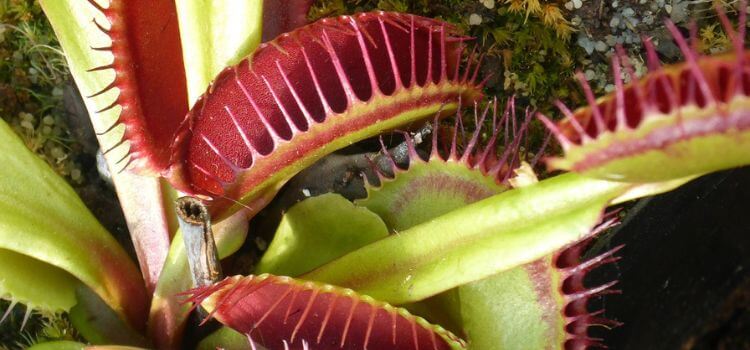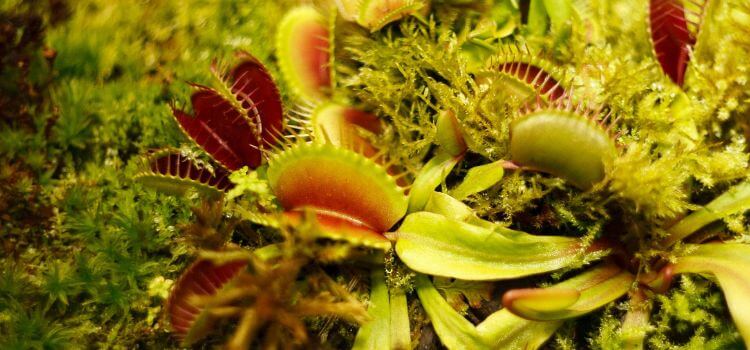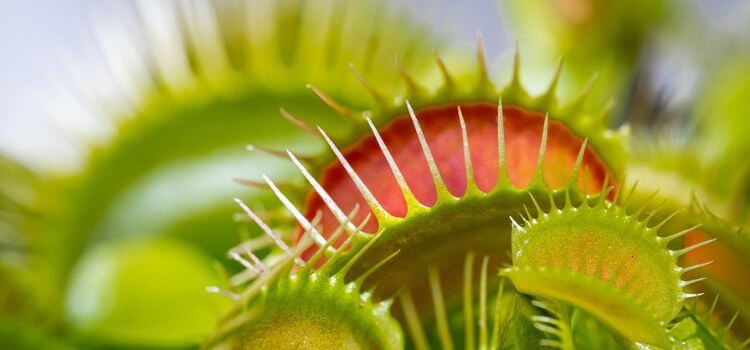As an Amazon Associate, I earn from qualifying purchases.
Your Venus Fly Trap may not close if it’s not stimulated correctly or if it’s unhealthy. Lack of light or overfeeding can also cause this issue.
Venus Fly Traps, known as Dionaea muscipula, are fascinating carnivorous plants that capture their prey with a unique snapping mechanism. They thrive in environments that mimic their natural habitat, which is the subtropical wetlands of the United States.
A healthy Venus Fly Trap requires a specific set of conditions to function correctly, including adequate sunlight, proper soil composition, and the right amount of water. Understanding these needs is crucial for the plant’s ability to feed and process nutrients effectively. When a Venus Fly Trap fails to close, it’s a clear indication that one or more of these conditions are not being met, signaling that it’s time for a caregiver to reassess and adjust the care routine.
Anatomy Of A Venus Fly Trap
The Venus Fly Trap is a marvel of nature. This carnivorous plant uses its unique leaves to trap and digest insects.
The Mechanism
Each leaf of a Venus Fly Trap is a sophisticated trap. The trap consists of two lobes that hinge together. The inner surfaces have sensitive trigger hairs. When an insect touches these, the trap springs shut.
Environmental factors and plant health impact this mechanism. A healthy trap snaps shut in less than a second!

Key Components
- Leaf Blade: The flat part that photosynthesizes and traps prey.
- Trigger Hairs: Sensitive hairs inside the lobes that initiate closure.
- Lobes: The two parts of the leaf that come together to form the trap.
- Midrib: The central vein that the lobes hinge upon.
Understanding these components helps diagnose why a trap might not close. A table can summarize potential issues:
| Component | Function | Common Issues |
|---|---|---|
| Leaf Blade | Photosynthesis and trapping | Insufficient light or energy |
| Trigger Hairs | Detecting prey | Damaged hairs, no response |
| Lobes | Capture and digestion | Dehydration, poor health |
| Midrib | Support and movement | Physical damage or fatigue |
Environmental Factors
Understanding the environmental factors is essential for a healthy Venus Fly Trap. If your plant won’t close, the environment might be the culprit.
Light Requirements
Venus Fly Traps need plenty of light. Without it, they struggle to thrive. Here’s what you need to ensure:
- Direct sunlight for at least 4 hours daily
- Use grow lights if natural light is scarce
- 12-16 hours of light per day for indoor plants
Adjust your plant’s location or lighting setup to meet these needs.
Humidity Levels
The right humidity level is critical for your Venus Fly Trap. Follow these tips:
- Maintain 60-80% humidity
- Use a humidity tray or misting to increase moisture
- Avoid dry air, which can prevent the trap from closing
Monitor with a hygrometer and adjust as needed for optimal plant health.
Feeding And Nutrition
Understanding feeding and nutrition is vital to keeping your Venus Fly Trap healthy. If it’s not closing, it might not be eating right.
Frequency Of Feeding
Your Venus Fly Trap needs the right amount of food. Do not feed it too much or too little.
- Feed once every two to three weeks.
- Only feed during active growing months, spring through fall.
- In winter, the plant rests and needs no food.
Stick to this schedule for a happy, snappy plant!
Supplemental Feeding
Sometimes, your plant might need extra nutrients, especially if it’s indoors.
| Type of Supplement | Frequency |
|---|---|
| Maxsea Plant Food | Once a month at 1/4 strength |
| Orchid fertilizer | Every two months at 1/4 strength |
Use these supplements carefully. Too much can harm your plant.

Common Issues
Is your Venus Fly Trap refusing to snap shut? This carnivorous plant relies on its quick closure to catch its prey, but sometimes things can go wrong.
Overfeeding
Feeding a Venus Fly Trap too much can be a problem. These plants need to conserve energy. Overfeeding can exhaust them, leading to trap inactivity. Here are signs of overfeeding:
- Trap fatigue: The plant’s traps may open more slowly or not fully close.
- Brown traps: Traps can turn brown and die off after excessive feeding.
Remember, Venus Fly Traps catch their food naturally. They only need feeding if they’re kept indoors and away from insects.
Pests And Diseases
Pests and diseases can also hinder a Venus Fly Trap’s ability to close. Common culprits include:
| Pest/Disease | Symptoms | Impact on Trap |
|---|---|---|
| Spider Mites | Webbing on plants, tiny red or yellow bugs | Weakened traps |
| Fungal Infections | White, fluffy mould on soil or plant | Rotting traps |
Keep an eye out for these issues. Regularly check your plant for signs of pests or disease and take action if needed. Healthy plants mean responsive traps!
Care And Maintenance
Venus Fly Traps need proper care to stay healthy. Sometimes, they won’t close. This can be a sign of trouble. Good care keeps them snapping up those flies!
Repotting Needs
These unique plants love fresh homes. Repot every 12 to 18 months. Use nutrient-poor soil, like sphagnum moss. This mimics their natural habitat.
- Choose the right pot: It should be slightly larger than the last one.
- Spring is best: This season is perfect for repotting.
- Be gentle: Their roots are delicate. Handle with care.
Seasonal Care
Venus Fly Traps have a winter dormancy period. They rest and save energy.
| Season | Care Tips |
|---|---|
| Spring | Start watering more. Increase sun exposure. |
| Summer | Keep soil moist. Feed them insects if indoors. |
| Fall | Reduce water. Prepare for dormancy. |
| Winter | Keep cool. Water less. No feeding is needed. |
In each season, light and water change. Match their natural cycle for the best health.
Reviving A Venus Fly Trap
Reviving a Venus Fly Trap can feel like a delicate mission. These carnivorous plants are famous for their jaw-like leaves that snap shut on prey. But what happens when your Venus Fly Trap won’t close? Don’t worry; with the proper care, you can bring your plant back to its bug-catching glory.
Troubleshooting Tips
- Lighting: Ensure it gets plenty of indirect sunlight.
- Water: Use distilled water or rainwater for hydration.
- Soil: The soil should be nutrient-poor and well-draining.
- Feeding: Only feed it small insects, and not too often.
- Rest: Remember, Venus Fly Traps need a dormancy period.
Check each of these areas and make adjustments as needed. Your plant may need a little tune-up to start thriving again.
Patience And Persistence
Healing a Venus Fly Trap isn’t instant. It requires patience. Here’s what to keep in mind:
- Time: Give your plant time to recover after making changes.
- Observation: Watch for new growth as a sign of recovery.
- Care: Continue providing consistent care as your plant heals.
Stay persistent with your care routine. Over time, you should see your Venus Fly Trap snapping shut once more.

Frequently Asked Questions
Your Venus flytrap may only close partially due to insufficient light, overfeeding, dormancy, or aging traps. Ensure it gets adequate sunlight and moderate feeding for optimal health.
To trigger a Venus flytrap’s closure, lightly touch the trigger hairs inside the trap twice. Avoid overstimulating the plant, as it can weaken it if done too frequently.
The Venus flytrap closes when sensory hairs on its lobes are stimulated twice within 20 seconds, signaling the presence of prey.
A Venus flytrap typically closes in about 10 seconds after its trigger hairs are stimulated. This rapid response allows it to catch prey efficiently.
Conclusion
Understanding the nuances of your Venus flytrap’s care is critical to ensuring those mesmerizing traps snap shut on cue. From ensuring proper lighting to maintaining the correct soil moisture, each element plays a vital role. Remember to avoid common pitfalls, and with a bit of patience, your carnivorous companion will thrive, showcasing its unique predatory dance once more.
Keep nurturing your plant, and it’ll reward you with its fascinating behavior.

